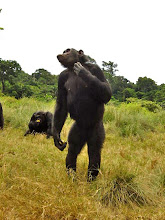 ..there is a great auction going on at Smågårde just outside Visby, Gotland. In the summer, it´s crowded with people from the mainland with money in their pockets. But now, in October, we, the natives can make real bargains. Entire farms from the island are often auctioned off - and the quality range from the very exquisite to affordable "wanna-have" bric-a-bracs.
..there is a great auction going on at Smågårde just outside Visby, Gotland. In the summer, it´s crowded with people from the mainland with money in their pockets. But now, in October, we, the natives can make real bargains. Entire farms from the island are often auctioned off - and the quality range from the very exquisite to affordable "wanna-have" bric-a-bracs.So we went, last Sunday.
My sister made a successful bid for this stereoscopy (see end of this blog comment) from the turn of the last century. (above)
 A great gadget with a number of old pictures/photos from the past!
A great gadget with a number of old pictures/photos from the past!
 (a bit of burlesque and daring photos too, no doubt!)
(a bit of burlesque and daring photos too, no doubt!)
 Popular auctioneer, Ulf in action. He is a master at creating a jolly ambiance and there are a lot of laughter amidst the efficiency!
Popular auctioneer, Ulf in action. He is a master at creating a jolly ambiance and there are a lot of laughter amidst the efficiency!
 A great gadget with a number of old pictures/photos from the past!
A great gadget with a number of old pictures/photos from the past!  (a bit of burlesque and daring photos too, no doubt!)
(a bit of burlesque and daring photos too, no doubt!) Popular auctioneer, Ulf in action. He is a master at creating a jolly ambiance and there are a lot of laughter amidst the efficiency!
Popular auctioneer, Ulf in action. He is a master at creating a jolly ambiance and there are a lot of laughter amidst the efficiency! Nena and Mia discussing if the pair of binoculars on the table are good enough for birdwatching -
Nena and Mia discussing if the pair of binoculars on the table are good enough for birdwatching -  -one of Mia´s great interests.
-one of Mia´s great interests.Now:
Guess what I brought home? My sister and my friend stuffed my car so full of good I could hardly close the booth! And I? I bought nothing. I am presently busy insulating my little well-over-100-year-old farmstead before the winter. Talking about antiquities!
And those many repairing activities do not exactly cost
" needle money" - as the saying goes in Sweden.
 "Rather warm feet,
"Rather warm feet,
 than hand embroidered sheet!"
than hand embroidered sheet!"
Stereoscopy (also called stereoscopic or 3-D imaging) refers to a technique for creating or enhancing the illusion of depth in an image by presenting two offset images separately to the left and right eye of the viewer. Both of these 2-D offset images are then combined in the brain to give the perception of 3-D depth. Three strategies have been used to accomplish this: have the viewer wear eyeglasses to combine separate images from two offset sources, have the viewer wear eyeglasses to filter offset images from a single source separated to each eye, or have the lightsource split the images directionally into the viewer's eyes (no glasses required; known as Autostereoscopy).
(Wiki)
Guess what I brought home? My sister and my friend stuffed my car so full of good I could hardly close the booth! And I? I bought nothing. I am presently busy insulating my little well-over-100-year-old farmstead before the winter. Talking about antiquities!
And those many repairing activities do not exactly cost
" needle money" - as the saying goes in Sweden.
 "Rather warm feet,
"Rather warm feet, than hand embroidered sheet!"
than hand embroidered sheet!"Stereoscopy (also called stereoscopic or 3-D imaging) refers to a technique for creating or enhancing the illusion of depth in an image by presenting two offset images separately to the left and right eye of the viewer. Both of these 2-D offset images are then combined in the brain to give the perception of 3-D depth. Three strategies have been used to accomplish this: have the viewer wear eyeglasses to combine separate images from two offset sources, have the viewer wear eyeglasses to filter offset images from a single source separated to each eye, or have the lightsource split the images directionally into the viewer's eyes (no glasses required; known as Autostereoscopy).
(Wiki)















































